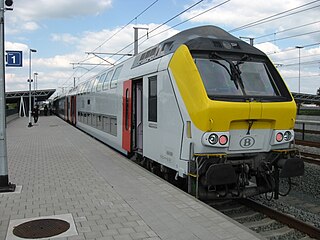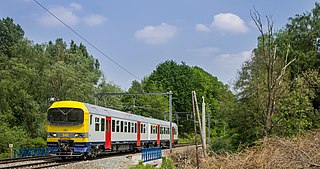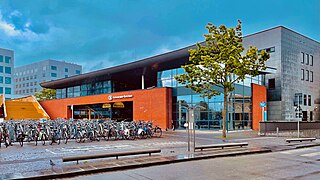The National Railway Company of Belgium is the national railway company of Belgium. The company formally styles itself using the Dutch and French abbreviations NMBS/SNCB. The corporate logo designed in 1936 by Henry van de Velde consists of the linguistically neutral letter B in a horizontal oval.

Belgium has an extensive rail network. It is a member of the International Union of Railways (UIC). The UIC Country Code for Belgium is 88.

Brussels-Central railway station, officially Brussels-Central, is a railway and metro station in central Brussels, Belgium. It is the second busiest railway station in Belgium and one of three principal railway stations in Brussels, together with Brussels-South and Brussels-North. First completed in 1952 after protracted delays caused by economic difficulties and World War II, it is the newest of Brussels' main rail hubs.

Brussels-Schuman railway station, officially Brussels-Schuman, is a railway station in the City of Brussels, Belgium, serving the European Quarter. It received its name from the area around the Robert Schuman Roundabout, itself named after Robert Schuman.

Brussels-South railway station, officially Brussels-South, is a major railway station in Brussels, Belgium. Geographically, it is located in Saint-Gilles/Sint-Gillis on the border with the adjacent municipality of Anderlecht and just south of the City of Brussels.

The HSL 2 is a Belgian high-speed rail line between Leuven and Ans and is 66.2 km (41 mi) long, all of it on dedicated high-speed tracks, which began service on 15 December 2002. As part of the Belgian railway network, it is owned, technically operated and maintained by Infrabel.

Antwerpen-Centraal railway station, officially Antwerpen-Centraal, is the main railway station in Antwerp, Belgium. The station is operated by the National Railway Company of Belgium (NMBS/SNCB).

Infrabel is a Belgian government-owned public limited company. It builds, owns, maintains and upgrades the Belgian railway network, makes its capacity available to railway operator companies, and handles train traffic control.

Schaerbeek railway station or Schaarbeek railway station is a railway station in the municipality of Schaerbeek in Brussels, Belgium, opened in 1887. The train services are operated by the National Railway Company of Belgium (NMBS/SNCB).

Belgium's high-speed rail network provides mostly international connections from Brussels to France, Germany and The Netherlands. The high-speed network began with the opening of the HSL 1 to France in 1997, and since then high-speed lines have been extended towards Germany with HSL 2 in 2002, HSL 3 from Liège to the German border in 2009, and HSL 4 from Antwerp to the Dutch border in 2009.

Brussels Airport-Zaventem is a railway station located beneath Brussels Airport in Zaventem, Flemish Brabant, Belgium. The station opened in 1958 on railway line 36C; in 2012, the new line 25N was added. The train services are operated by the National Railway Company of Belgium (NMBS/SNCB).
The Halle train collision was a collision between two NMBS/SNCB passenger trains carrying a combined 250 to 300 people in Buizingen, in the municipality of Halle, Flemish Brabant, Belgium, on 15 February 2010. The accident occurred in snowy conditions at 08:28 CET (07:28 UTC), during rush hour, on railway line 96 (Brussels–Quévy) about 12 kilometres (7.5 mi) from Brussels between P-train E3678 from Leuven to Braine-le-Comte and IC-train E1707 from Quiévrain to Liège. A third train was able to come to a stop just in time. The collision killed 19 people and injured 171, making it the deadliest rail accident in Belgium in over fifty years.

The Belgian railway line 36 is a railway line in Belgium connecting Brussels to Liège. Completed in 1866, the line runs 99.3 km. Trains running between Brussels and Aachen in Germany use the line as far as Liège, and then line 37 between Liège and the German border, the last stop in Belgium being Welkenraedt.

The Belgian railway line 25 is the oldest railway line in Belgium. It connects Belgium's two main cities: Brussels and Antwerp. The section between Brussels and Mechelen was completed in on 5 May 1835 and was the first railway in Belgium and the first public passenger steam railway on the European continent. On 3 May 1836 the second section, between Mechelen and Antwerp, was opened. It was extended to Luchtbal in the north of Antwerp in 2007 in order to shorten the route from Amsterdam to Brussels. The total line runs 47.6 km (29.6 mi).

Leuven railway station, officially Leuven, is the main railway station in Leuven, Flemish Brabant, Belgium. The station is operated by the National Railway Company of Belgium (NMBS/SNCB) and is located on railway line 36. In 2007, it was the fifth-busiest station in Belgium, only preceded by the three main Brussels stations and Gent-Sint-Pieters railway station.

The Brussels S-train, also known as the Brussels Regional Express Network is a suburban rail system in and around the Brussels-Capital Region of Belgium. It will offer fast connections and increased frequency within a 30 km (19 mi) radius of the region, covering a territory inhabited by 2.5 million people.

Antwerpen-Berchem railway station, officially Antwerpen-Berchem, is a railway station in Berchem, in the south of Antwerp, Belgium. The station opened on 1 March 1865 and currently serves railway lines 25, 27, 27A and 59. The train services are operated by the National Railway Company of Belgium (NMBS/SNCB).

Mechelen railway station, officially Mechelen, is a railway station in Mechelen, Antwerp, Belgium. The station opened on 5 May 1835 on railway lines 25, 27 and 53. Train services are operated by the National Railway Company of Belgium (NMBS/SNCB).

Braine-l'Alleud railway station, officially Braine-l'Alleud, is a railway station in Braine-l'Alleud, Walloon Brabant, Belgium, operated by the National Railway Company of Belgium (SNCB/NMBS). The station is located on railway line 124, from Brussels-South to Charleroi-Central.
Wijgmaal railway station is a Belgian railway station located on Line 53, located in Wijgmaal, a village located within the boundaries of the city of Leuven, in Flemish Brabant in the Flemish Region of the country.


















